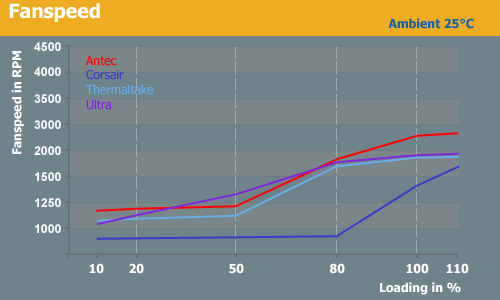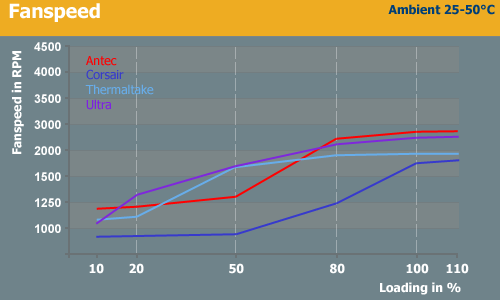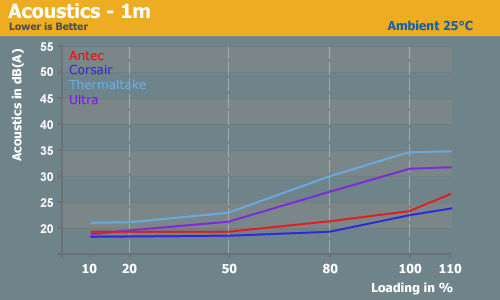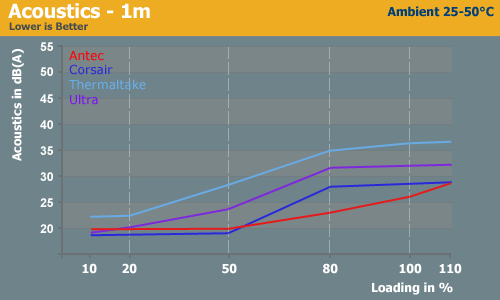400-450W PSU Roundup
by Christoph Katzer on November 6, 2007 4:00 AM EST- Posted in
- Cases/Cooling/PSUs
Comparison
With the four power supplies tested today, we can get a basic idea about the products in the market. Unfortunately, this is a market where higher quality power supplies are getting rare since 500W is the lower end for most companies. A few good manufacturers make 400W and maybe sometimes 350W models, but with many graphics cards "requiring" 500W and higher power supplies marketing has definitely moved to less reasonable units. Rather than creating a good quality 350W power supply, most manufacturers are more interested in attaching a few more cables, adding a couple more components, and selling a 500W (or higher) power supply.
Seasonic is one of the few companies that continue to cater to this market, so it's not too surprising that in addition to their own brand they are also the production facility for the Earthwatts and Corsair power supplies. Staying with Seasonic, however, the M12II series will come out soon and Seasonic wants to start the series at 500W -- just as they did with the first M12 series. That leaves Maxpoint as one of the only remaining companies looking to continue producing lower wattage models.
Despite the marketing hype, many users really have no need for anything beyond a moderate 400W power supply, and perhaps not even that. Consider our results from the GeForce 8800 GT article: with an upper-midrange system, we still topped out at a whopping 327W -- and that's power draw from the wall, not power supply output! Assuming 80% efficiency for the power supply, that particular test system is only using around 260W of power.
As we have seen today, of course, simply going out and grabbing any old 400W power supply might not be a good idea for such a system. While three of the tested power supplies today perform well, we would be very concerned with the prospect of using something like the Ultra 400W. As usual, you get what you pay for. Unfortunately, it seems as though most of the quality power supplies in this range will disappear over the coming year or two, leaving the lower wattage market to cheaper designs that really underperform.
Before we wrap up, let's take a quick look at how the power supplies stack up in a few meaningful areas. We'll start with fan speeds and acoustics.


Corsair clearly has the lowest fan speeds in comparison to the other units. It stays below 1000 RPM until a load of more than 350W is applied. In most actual computers, it will be nearly silent. The other units start to ramp up fan speeds much earlier, which should be not necessary. Corsair keeps the lead even under higher ambient temperatures, despite the fact that the other three power supply fans are spinning 50% faster. Fan speed doesn't really count for noise levels or fan size, however, so let's look at noise measurements.


Comparing the acoustics is interesting because the Antec shows its potential here. The fan turns slightly faster but still produces less noise. Both the Antec and Corsair have a very low noise level and are practically silent. If you're interested in a low wattage, low noise level PSU, Antec and Corsair are definitely worth a look (as well as Seasonic, naturally). The other two power supplies don't do nearly as well. Thermaltake is even louder than the Ultra unit is, even though the fan spins at lower RPMs. Thermaltake should definitely think about changing the fan -- or maybe redesigning the fan grill, heatsinks, or whatever else is necessary -- to bring performance up to the level of Seasonic, et al.
With the four power supplies tested today, we can get a basic idea about the products in the market. Unfortunately, this is a market where higher quality power supplies are getting rare since 500W is the lower end for most companies. A few good manufacturers make 400W and maybe sometimes 350W models, but with many graphics cards "requiring" 500W and higher power supplies marketing has definitely moved to less reasonable units. Rather than creating a good quality 350W power supply, most manufacturers are more interested in attaching a few more cables, adding a couple more components, and selling a 500W (or higher) power supply.
Seasonic is one of the few companies that continue to cater to this market, so it's not too surprising that in addition to their own brand they are also the production facility for the Earthwatts and Corsair power supplies. Staying with Seasonic, however, the M12II series will come out soon and Seasonic wants to start the series at 500W -- just as they did with the first M12 series. That leaves Maxpoint as one of the only remaining companies looking to continue producing lower wattage models.
Despite the marketing hype, many users really have no need for anything beyond a moderate 400W power supply, and perhaps not even that. Consider our results from the GeForce 8800 GT article: with an upper-midrange system, we still topped out at a whopping 327W -- and that's power draw from the wall, not power supply output! Assuming 80% efficiency for the power supply, that particular test system is only using around 260W of power.
As we have seen today, of course, simply going out and grabbing any old 400W power supply might not be a good idea for such a system. While three of the tested power supplies today perform well, we would be very concerned with the prospect of using something like the Ultra 400W. As usual, you get what you pay for. Unfortunately, it seems as though most of the quality power supplies in this range will disappear over the coming year or two, leaving the lower wattage market to cheaper designs that really underperform.
Before we wrap up, let's take a quick look at how the power supplies stack up in a few meaningful areas. We'll start with fan speeds and acoustics.


Corsair clearly has the lowest fan speeds in comparison to the other units. It stays below 1000 RPM until a load of more than 350W is applied. In most actual computers, it will be nearly silent. The other units start to ramp up fan speeds much earlier, which should be not necessary. Corsair keeps the lead even under higher ambient temperatures, despite the fact that the other three power supply fans are spinning 50% faster. Fan speed doesn't really count for noise levels or fan size, however, so let's look at noise measurements.


Comparing the acoustics is interesting because the Antec shows its potential here. The fan turns slightly faster but still produces less noise. Both the Antec and Corsair have a very low noise level and are practically silent. If you're interested in a low wattage, low noise level PSU, Antec and Corsair are definitely worth a look (as well as Seasonic, naturally). The other two power supplies don't do nearly as well. Thermaltake is even louder than the Ultra unit is, even though the fan spins at lower RPMs. Thermaltake should definitely think about changing the fan -- or maybe redesigning the fan grill, heatsinks, or whatever else is necessary -- to bring performance up to the level of Seasonic, et al.










37 Comments
View All Comments
opterondo - Sunday, November 18, 2007 - link
You all do understand that a 1000w PSU doesn't use 1000w right?For instance you hook up 333w peak load worth of components to it it will use ~333w.
The only reason to buy a smaller capacity PSU is up front price and possibly better AC-DC conversion efficiency (like maybe 70% instead of 60%)
opterondo - Sunday, November 18, 2007 - link
Good thing they didn't review any of the COOLMAX PSUs cause they are fairly priced and out perform most any in this article.COOLMAX CX-400B ATX v2.01
COOLMAX CP-500T EPS12V
COOLMAX CXI-500B ATX12V
COOLMAX CUG-700B ATX 12V( V.2.2)
mindless1 - Thursday, November 15, 2007 - link
Months ago I was almost given a vacation in the forums because of shills and naive owners that wouldn't accept my negative comments about Ultra V-Series. I feel a bit vindicated and yet the review didn't even touch in it's primary weakness, poor capacitors leading to poor lifespan even in a system it would be suited to run in.I do have to disagree about one aspect of the review in that the Ultra does have PFC just not active or APFC, and an "old" passive PFC design is not a big deal, a PSU can run fine w/o AFPC and historically there were plenty of decent, not just cheap, PSU with passive PFC evidenced by the input voltage selection switch.
Also in the reviews, please mention the fans' make model and bearing(s) type as they are also weak links when cheap sleeve-bearing types are used.
Kougar - Friday, November 9, 2007 - link
On many of the pages I am seeing empty image placeholders that link to 0x0 pixel images that are 1.5KB in size... someone might want to fix that. :)Christoph Katzer - Friday, November 9, 2007 - link
Working fine here ;)Kougar - Wednesday, November 14, 2007 - link
Do you work for Anandtech???Since an image is worth a thousand words: http://i111.photobucket.com/albums/n129/Chanur64/M...">Image Link
The "missing" ghost image placeholder shows up for every PSU info page.
Christoph Katzer - Thursday, November 15, 2007 - link
Oh yep thanks. Now it's working.grantschoep - Thursday, November 8, 2007 - link
Low end power supplies?I want to to know who the heck needs a 500+ watt power supply that isn't running some crazy dual SLI setup. I really wish power supply makers would focus on quite and very stable/clean voltages.
I wish companies would really focus on very high quality low end systems. 98% of us don't need a 500+ watt power supply. 90% of us don't need a motherboard with as much crap as they tack on(2 1gig network ports for example)
As an electrical engineer, 1 US dollar extra.... could by much better caps and the like.
Heck as a further annoyance, when company A has a PSU fan that is better/quiter than another, why go whit the lesser
I really wish that companies would focus on this. I don't need a 1 KW beast. I want a good, high quality ~450 watt supply that is nice and quite.
erple2 - Thursday, November 8, 2007 - link
I am a bit saddened by the (IMO) relatively unimportant temperature of the heatsinks, or sound ouput. IMO, the single most important measurement of the usefulness of a power supply is, in fact, it's ability to supply power.I would equate evaluating it's value on thermal and acoustic characteristics to evaluating the superiority of a GFX card on it's thermal characteristics. For that effect, my old Matrox Millenium card destroys an 8800GTX.
Seriously, I'd really like to see much more in-depth analysis and evaluation on the stability of the power generation, the cleanliness of the signal, the resistance to sagging based on varying the power requirements, etc.
I understand that acoustics and thermals are important, but they're really secondary to the actual performance of the power generation. If you're overly concerned with the loudness of a power supply, or how hot it gets, instead of the actual performance of the power supply, then maybe you shouldn't be using a computer..
Christoph Katzer - Friday, November 9, 2007 - link
Did you just read the comparison or?